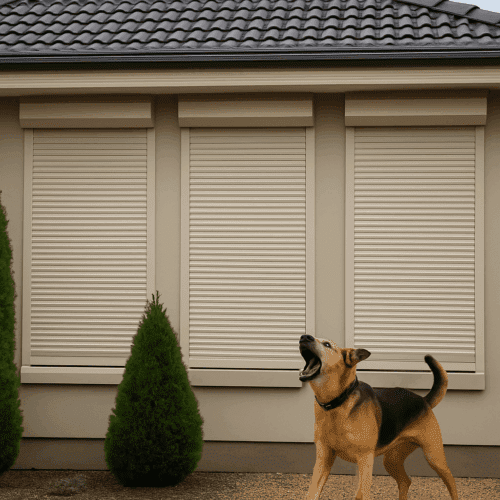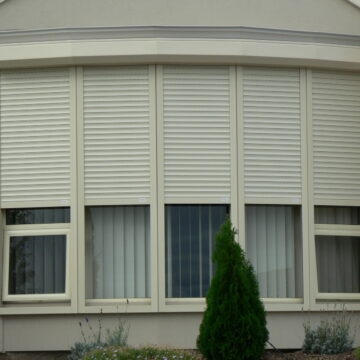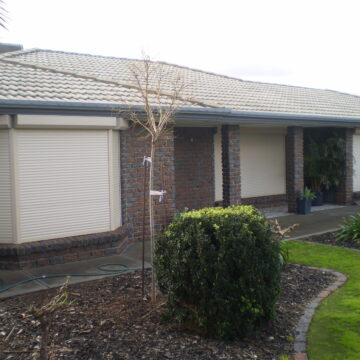If traffic rumble, barking dogs or dawn garbage trucks keep echoing through your windows, a properly engineered roller shutter can give you back the quiet. Independent tests show quality aluminium shutters, correctly fitted, trim external noise by around 8–19 dB — roughly 40 to 80 percent of what your ears perceive — without turning the room into a sealed studio.
This buyer’s guide breaks down how that performance is achieved, which specs genuinely matter, and the price brackets you can expect across Adelaide and the rest of Australia. You’ll learn realistic expectations, measurement tips, installation pitfalls, and the extras — insulation, security, blackout, energy savings — that often clinch the decision. Let’s get started on choosing peace and quiet that actually works.
How Roller Shutters Reduce Noise: The Science Explained
Before you compare brochures, it helps to know why some shutters silence a busy street while others just look the part. At its core, noise control is a game of mass, airtightness and distance—fundamentals a good roller shutter turns into usable quiet.
Acoustic principles every buyer should know
Sound energy can be
- reflected (bounced back),
- absorbed (converted to heat), or
- damped (dissipated by friction).
The result is expressed as a decibel drop: dB = 10 × log10(P₂ / P₁). Because the decibel scale is logarithmic, a 10 dB cut feels roughly half as loud. High-frequency hiss is fairly easy to block; low-frequency rumbles from trucks carry more energy and need extra mass and sealing.
Anatomy of a roller shutter as a sound barrier
Aluminium slats are typically double-walled and filled with rigid polyurethane foam. This sandwich adds both mass and internal damping, breaking up airborne waves before they reach the glass. Side-channel brushes seal micro-gaps, the pelmet stops sound spilling over the head of the window, and a hefty bottom bar clamps everything tight when closed. Take away any one of those components and flanking paths undo the gains.
Typical, tested performance figures
Independent Australian lab tests show quality shutters achieving Rw/STC ratings of 28–36. In plain English that equals an 8–19 dB reduction, or about 40–80 % perceived quiet, depending on frequency mix and installation quality. “Up to 80 % quieter” headlines refer to the top end of that spread under controlled conditions—not every window, every day.
Limits and misconceptions
Roller shutters tackle airborne noise, not structure-borne vibration from sub-woofers or passing freight trains. They also won’t create a recording-studio silence; you’re buying noise reduction, not complete soundproofing. Knowing the difference prevents disappointment and helps you budget for layered solutions if needed.
More Than Silence: Additional Benefits Worth Considering
Quiet is the headline act, but a well-built roller shutter brings a bundle of side perks that quickly justify the spend—especially in Adelaide’s baking summers and nippy winters. Below are four extras buyers consistently rave about.
Better sleep, concentration and well-being
By muting dawn traffic and late-night pub chatter, shutters help shift workers, newborns and home-office users maintain consistent REM cycles and sharper focus. Studies link even modest dB drops to lower cortisol and improved mood, so the health dividend can be real.
Thermal insulation and energy savings
The same foam core that blocks sound forms a 6–8 mm thermal break, trimming up to 30 % of heat gain in summer and loss in winter. Expect air-con to cycle less and the heater dial to drop a notch, reducing energy bills without sacrificing comfort.
Enhanced security and privacy
Interlocking aluminium slats create a physical barrier that deters smash-and-grab attempts and prying eyes alike. Remote control lets you fine-tune visibility, keeping valuables out of sight while still admitting light when required.
Full blackout and light management
When fully lowered, side seals and overlapping slats deliver near-cinema darkness—perfect for movie nights, day sleeping or protecting furniture from UV fade. Partial opening lets you modulate glare without lifting the whole curtain.
Choosing the Right Noise-Reducing Roller Shutter
Not every shutter that claims “acoustic” will earn its keep. Match the build to your window size, exposure and lifestyle, then check the paperwork. The five checkpoints below will steer you past marketing fluff and toward proven quiet.
Material comparison: aluminium vs steel vs PVC
- Aluminium – sweet-spot for mass-to-weight, corrosion proof, Rw 28-36, friendly on tubular motors.
- Steel – heavier (better bass blocking) but rust-prone near coast and needs beefier hardware.
- PVC – budget, light, limited to small spans, Rw mid-20s; warps under Adelaide heatwaves.
Slat designs and insulation options
| Slat type | Thickness (mm) | Weight (kg /m²) | Typical Rw | Price impact |
|---|---|---|---|---|
| Single-wall aluminium | 8 | 3.5 | 26-28 | –10 % |
| Double-wall std. PU | 9 | 4.1 | 30-32 | baseline |
| High-density PU | 9 | 4.6 | 33-35 | +8 % |
| Vision/perforated | 9 | 4.0 | 27-29 | +5 % (adds light) |
Skip perforated “vision” rows on bedrooms overlooking busy roads.
Manual, battery or mains-electric operation
Strap winders punch a 15 mm hole through the wall—an instant leak path. Battery and 240 V motors keep the cavity sealed and add one-button convenience; look for ≤45 dB motor specs for nursery windows.
Sizing, colour, bush-fire and cyclone ratings
Large sliders may need split shutters or 60 mm slats to avoid sag. Dark colours absorb heat—ensure powder-coat carries a 10-year warranty. BAL-40 or cyclone-rated profiles gain structural heft but usually keep the same acoustic score.
Certifications and test reports to ask for
Request an AS/NZS 4347 or ISO 10140 lab sheet showing octave-band data, not just the headline “up to 80 % quieter”. A supplier who hesitates probably doesn’t have one.
Measure Your Noise Problem Before Ordering
A shiny brochure promise means little if you don’t first quantify the racket you’re fighting. A quick weekend of measurement tells you whether roller shutters for noise reduction alone will do the job or if you’ll need extra layers.
Identify dominant sources and frequencies
Different sounds occupy different bands, and shutters block some bands better than others.
| Noise source | Typical peak (Hz) | Roller-shutter effectiveness |
|---|---|---|
| Cars at 50 km/h | 200–800 | High |
| Heavy trucks | 50–200 | Moderate |
| Aircraft on approach | 100–400 | Moderate |
| Barking dogs | 500–1 000 | High |
| Late-night voices | 1 000–3 000 | Very high |
Low-frequency rumbles carry more energy, so expect smaller dB drops there than in the chatter range.
Simple measurement methods
- Download a free class-2 phone app such as “Decibel X”.
- Hold the mic 1 m from the window; log average and peak dB every hour for 24 h.
- For greater accuracy, hire a calibrated meter from an AV shop—about $40 a day.
Site and building considerations
Corner rooms, timber frames and old sash gaps leak sound even with a shutter down. Note façade materials, window orientation and any vents that bypass the opening.
When you’ll need a layered approach
If peak readings exceed 75 dB, or bass frequencies dominate, plan to pair shutters with acoustic glazing, perimeter seals or even an internal secondary wall to chase >40 dB overall reduction.
Installation Details That Make or Break Performance
Even the best-spec slats will underwhelm if they’re hung with gaps or rattling in the wind. Acoustic gain hinges on millimetre accuracy, airtight joints and components that keep their shape over decades of Adelaide heat and brick movement.
Professional installation vs confident DIY
A seasoned installer lasers the opening, planes shims to 0.5 mm, and seals the back of the headbox before the shutter ever moves. Miss just a 3 mm crescent beside the track and laboratory figures crash by up to 5 dB. Skilled DIYers can save labour, but budget for masonry bits, rivet guns, a helper to lift the roll and the risk of lost warranty if the curtain later drags.
Side tracks, brushes and seals
Side channels should cup the slat edges with twin nylon brushes; these damp micro-vibrations and plug pinholes of daylight (and sound). Look for tracks with a 53 mm internal depth and replaceable insert strips—cheaper pressed-metal versions warp and whistle after a couple of summers.
Retrofitting on older frames
Uneven brick coursing? Go face-fit and bed the tracks in high-density backer rod plus UV-stable sealant. Reveal fits look neater on new aluminium frames but can telegraph noise through the jamb if screws touch the inner lining—use nylon isolator washers.
Ongoing upkeep
Wash slats annually, vacuum track brushes and spray silicone into the side guides. Swap perished rubber stoppers and tired seals early; a $15 part often restores the original acoustic rating of your roller shutters for noise reduction.
Roller Shutters vs Other Noise-Control Solutions
Not every noise complaint needs aluminium armour. Below we stack roller shutters against other common fixes so you can weigh dollars, decibels and side benefits before opening the wallet.
Double glazing or secondary glazing
Dual panes separated by a 100 mm air gap score Rw 35–42—great for bass—but expect $800–$1,500 /m² installed and occasional condensation around aluminium frames.
Acoustic curtains, blinds and internal shutters
Heavy 700 gsm velvet or honeycomb blinds shave 5–7 dB, cost $150–$400 per opening, and still let through low-frequency truck rumble.
Exterior awnings and louvre systems
Fixed awnings or adjustable louvres barely cut 2–4 dB but excel at summer shading; councils often approve them on heritage façades where shutters are barred.
Overall cost-to-benefit snapshot
- Roller shutters: 8–19 dB, $450–$700 /m², adds security & blackout
- Double glazing: 25–35 dB, $800–$1,500 /m², minimal security
- Curtains/blinds: 5–7 dB, $150–$400, decorative only
- Awnings/louvres: 2–4 dB, $250–$600 /m², great for heat control
Budget, Rebates and Long-Term Costs
Noise control is an investment, so pencil out the numbers before signing a contract and compare them with what silence is worth to you.
Typical price ranges in Australia (installed)
Expect about $800–$1000 for a 1 m² bedroom window, $2,200–$2,800 for a double patio door, and $400 + extra for motorization.
Running costs and energy savings
Modern tubular motors sip 0.5 W on standby—around $1.20 yearly—while shutter insulation can shave 10–15 % off HVAC bills for most homes.
Repair, parts and upgrade expenses
Common spares are budget-friendly: replacement straps $25, side seals $40 a pair, motors $280, and full slat curtain swap roughly $450.
Possible government incentives
Check SA’s Retailer Energy Productivity Scheme; several providers rebate up to $250 when shutters cut verified heating loads.
Quick Answers to Frequently Asked Questions
Do roller shutters completely soundproof a room?
Not quite. High-spec aluminium shutters typically cut airborne noise by 8–19 dB, which feels 40–80 % quieter, but they won’t kill deep vibration or make recording-studio silence.
How much reduction on a busy main road?
Expect around 8–12 dB, roughly halving what your ears register, assuming airtight installation and insulated slats.
Will the motor or wind rattling create new noise?
Premium tubular motors hum at only 40–45 dB and anti-rattle locks keep the curtain steady, so added noise is negligible.
Can I fit noise-reducing shutters on large sliders or shopfronts?
Yes—use wider slats, split panels or heavier duty motors; spans up to 6 m are common.
Are there building regulations I should know about in SA?
Most councils allow external shutters, but heritage overlays, strata bylaws or streetscape controls may require prior approval—always check before ordering.
Final Checklist for Peace and Quiet
- Log outside and inside dB levels for at least 24 hours.
- Choose double-walled, foam-filled aluminium slats for optimal mass and damping.
- Ask for AS/NZS 4347 or ISO 10140 test sheets—accept no vague claims.
- Insist on airtight fitting: sealed headbox, brush-lined tracks and screw isolators.
- Size motors and tracks to span; quiet hardware beats bargain gear that rattles.
- Factor side benefits—thermal cut, blackout, security—into your return-on-investment math’s.
Ready to reclaim calm? Book a free on-site noise assessment and quote with the friendly crew at Classic Roller Shutters Adelaide today.




